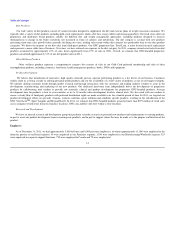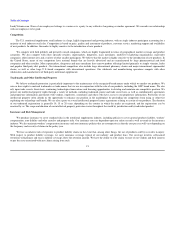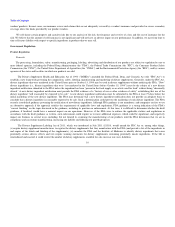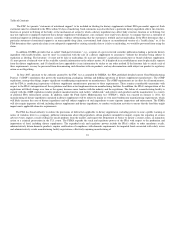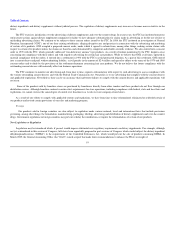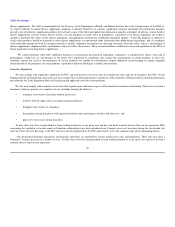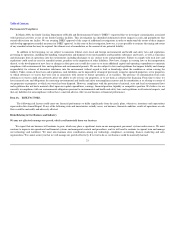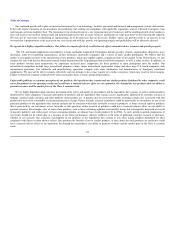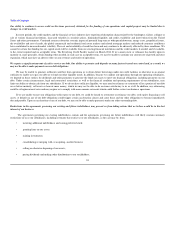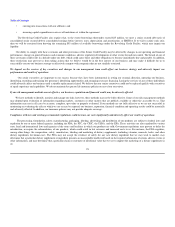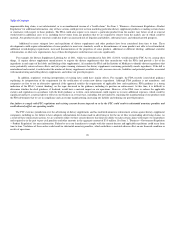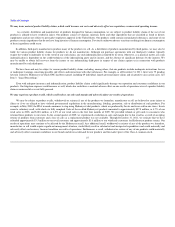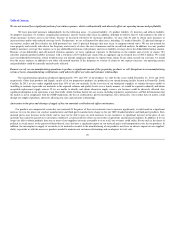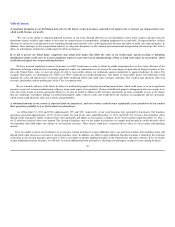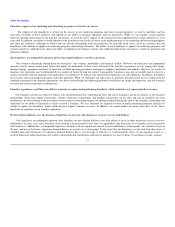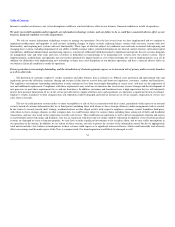GNC 2012 Annual Report Download - page 26
Download and view the complete annual report
Please find page 26 of the 2012 GNC annual report below. You can navigate through the pages in the report by either clicking on the pages listed below, or by using the keyword search tool below to find specific information within the annual report.
Table of Contents
Our ability to continue to access credit on the terms previously obtained for the funding of our operations and capital projects may be limited due to
changes in credit markets.
In recent periods, the credit markets and the financial services industry have experienced disruption characterized by the bankruptcy, failure, collapse or
sale of various financial institutions, increased volatility in securities prices, diminished liquidity and credit availability and intervention from the United
States and other governments. Continued concerns about the systemic impact of potential long-term or widespread downturn, energy costs, geopolitical issues,
the availability and cost of credit, the global commercial and residential real estate markets and related mortgage markets and reduced consumer confidence
have contributed to increased market volatility. The cost and availability of credit has been and may continue to be adversely affected by these conditions. We
cannot be certain that funding for our capital needs will be available from our existing financial institutions and the credit markets if needed, and if available,
to the extent required and on acceptable terms. The Revolving Credit Facility matures in March 2016. If we cannot renew or refinance this facility upon its
maturity or, more generally, obtain funding when needed, in each case on acceptable terms, we may be unable to continue our current rate of growth and store
expansion, which may have an adverse effect on our revenues and results of operations.
We require a significant amount of cash to service our debt. Our ability to generate cash depends on many factors beyond our control and, as a result, we
may not be able to make payments on our debt obligations.
We may be unable to generate sufficient cash flow from operations or to obtain future borrowings under our credit facilities or otherwise in an amount
sufficient to enable us to pay our debt or to fund our other liquidity needs. In addition, because we conduct our operations through our operating subsidiaries,
we depend on those entities for dividends and other payments to generate the funds necessary to meet our financial obligations, including payments on our
debt. Under certain circumstances, legal and contractual restrictions, as well as the financial condition and operating requirements of our subsidiaries, may
limit our ability to obtain cash from our subsidiaries. If we do not have sufficient liquidity, we may need to refinance or restructure all or a portion of our debt
on or before maturity, sell assets or borrow more money, which we may not be able to do on terms satisfactory to us or at all. In addition, any refinancing
could be at higher interest rates and may require us to comply with more onerous covenants which could further restrict our business operations.
If we are unable to meet our obligations with respect to our debt, we could be forced to restructure or refinance our debt, seek equity financing or sell
assets. A default on any of our debt obligations could trigger certain acceleration clauses and cause those and our other obligations to become immediately
due and payable. Upon an acceleration of any of our debt, we may not be able to make payments under our other outstanding debt.
Restrictions in the agreements governing our existing and future indebtedness may prevent us from taking actions that we believe would be in the best
interest of our business.
The agreements governing our existing indebtedness contain and the agreements governing our future indebtedness will likely contain customary
restrictions on us or our subsidiaries, including covenants that restrict us or our subsidiaries, as the case may be, from:
incurring additional indebtedness and issuing preferred stock;
granting liens on our assets;
making investments;
consolidating or merging with, or acquiring, another business;
selling or otherwise disposing of our assets;
paying dividends and making other distributions to our stockholders;
24
•
•
•
•
•
•


